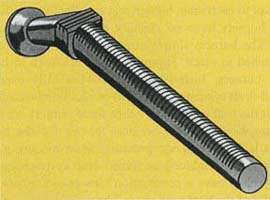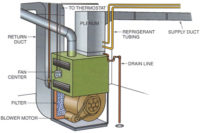Last night was the first night of really cold weather and it is still cold in the morning when Bob gets a call from the dispatcher that a customer has a carbon monoxide (CO) detector alarm that is sounding off. Bob tells the dispatcher to give him the customer's phone number and he calls the customer on his cell phone and tells the customer to shut off the furnace, get all people out of the house, open the front and back doors, and get out himself. Then he explains that he will be there within 30 minutes.
Bob is driving to the job when Btu Buddy says, "That was good advice you gave the customer. When CO is involved, you can't be too cautious."

Bob arrives at the house and sees that the front door is open and the family is sitting outside in the car. The homeowner then steps out of the car to talk to Bob and says, "This has put us in an uncomfortable position, waiting in the car. Was it necessary?"
Bob explains, "CO is very dangerous. It is not like breathing some smoke where you can step outside and clear your lungs. CO accumulates in the body and does not just clear out with good fresh air. It is vital to not let it accumulate. Tell me what happened."
The owner then tells Bob, "I bought two CO detectors (Figure 1) at a local hardware store last week. One was for our house and one for our daughter and her family at their house. I plugged ours in last week and it has been doing fine, no alarms. Last night it was cold and I built a fire in the fireplace in the den. Later in the night, the CO alarm went off. I got up and looked at it. I decided that it must be bad so I unpacked the second alarm and put a battery in it and plugged it in. I went back to sleep and about 30 minutes later it went off. I just figured they must both be bad so I packed them back up. When I got up this morning, I decided to try one of them again and it went off while I was getting dressed. I decided to call your company to do a checkup."
Bob says, "I am glad you called us. It is best to be safe about this. I have an instrument to detect CO in the house, but there is no need to test now with the doors open. I suspect that the fire in the fireplace plays a part in this. I will inspect everything and find the problem before I leave. Is there still a fire in the fireplace?"
The owner says, "Yes, I built it up real big before I went to bed and there were plenty of coals left this morning. I put several logs on the fire when I got up. It should be burning good."

Bob removes the front panel from the furnace and it is easy to see what the problem is. The furnace has slotted type burners (Figure 3) with adjustable air shutters, and they have a lot of lint in them. They had been burning with a yellow air-starved flame and had built up quite a bit of soot in the furnace. This is going to be a furnace cleaning job.
Bob goes back outside to the homeowner and tells him that the family could come back in as the house was completely aired out. He then explains what had happened. He also explains that, when a fire is in the fireplace, it has to be able to get plenty of air by slightly opening a window in the room with the fireplace. Bob asks the owner to go to the furnace room with him and he shows the owner with a candle flame what was happening.
Bob then goes to the den where the fireplace is located and opens an outside window about 3 inches. Then they go back to the furnace room and the candle shows that air is moving up the vent, even without the furnace running. This is the way it should be. The homeowner says, "This is the first time a service technician has ever showed me how a system works. Thanks."

"Yes," says Bob, and he goes to work.
There is quite a bit of soot in the furnace heat exchanger so Bob removes the draft diverter and uses long brushes and a shop vacuum to clean the top end of the furnace. He removes the burners and takes them outside, and uses compressed air to blow them out. The brushes and shop vacuum are used to clean the area where the burner slots are located. When the furnace is clean and the burners replaced, Bob starts the furnace. The flames are orange at first because of all of the dust in the air. When the furnace begins to get hot, the flames become blue like they should be.
Bob replaces the furnace door and rechecks the flue with a candle, and it is drafting as it should.
Bob then goes to the homeowner and says, "Fireplaces are really nice, but they can create problems if they are not operated correctly. They are not very efficient for heating unless the air for combustion can be pulled from outdoors and not through the room. The most heat you get from the fireplace is the radiant heat from the glowing fire."
The homeowner responds, "I was not aware of these operating characteristics of an open fireplace. Now that you have explained it, I understand. A fire is mainly for decoration unless managed correctly."
"That is correct," says Bob. "Your system is in good shape now. The dryer in the room with the furnace is not a great combination, but that is about all you can do in this case. It is a good idea to make sure the dryer vent is always good and clean. At least this dryer vent goes through the wall and doesn't have a long run of vent pipe. Your new CO detectors really did their job. They told you there was a problem. I am glad you called us instead of just returning them to the store."
Btu Buddy says as they are leaving the job, "I can see that you are going to be a Btu Buddy to a technician someday because you really care about the quality of work that you do."
Bob says, "Thanks, that is a compliment."
Bill Johnson has been active in the HVACR industry since the 1950s. He graduated in gas fuel technology and refrigeration from the Southern Technical Institute, a branch of Georgia Tech (now known as Southern Polytechnic Institute). He taught HVAC classes at Coosa Valley Vocational & Technical Institute for four years. He moved on to become service manager for Layne Trane, Charlotte, N.C. He taught for 15 years at Central Piedmont Community College, part of this time as program director. He had his own business for five years doing installation and service work. Now retired, he is the author of Practical Heating Technology and Practical Cooling Technology, and continues as a co-author of Refrigeration & Air Conditioning Technology, 5th Edition, all published by Delmar Publishers. For more information, he can be reached at 704-553-0087, 704-643-3928 (fax), or billj@carolina.rr.com.
Publication date: 11/28/2005







